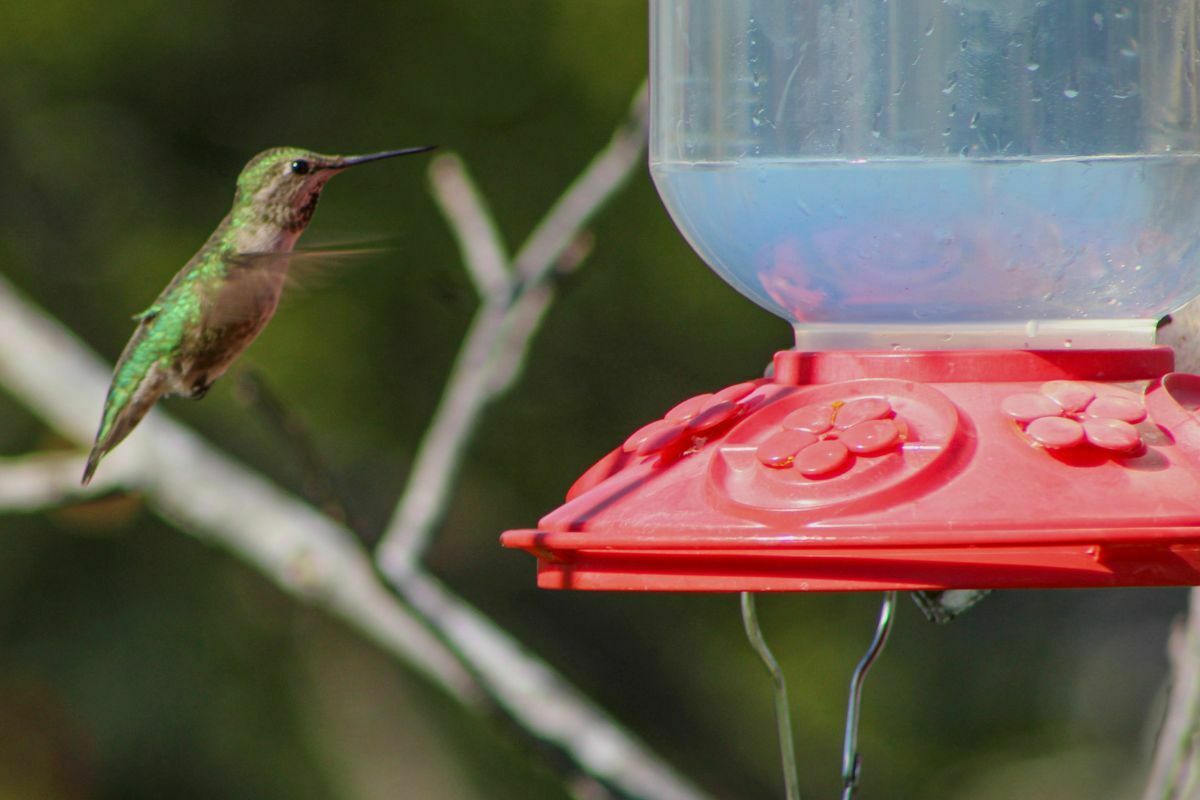Hummingbird watching is a great way to connect with nature and spend a relaxing afternoon at home, and one of the best ways to attract hummingbirds is to use a hummingbird feeder. The variety of birds that come around your feeders is amazing, whether you’re watching hummingbirds or bluejays.
However, hummingbird watching, hummingbird feeders, and bird watching, in general, may appear to be a very complicated thing to get involved in, but as a newcomer, it may appear to be an even more daunting task.
Whether you’re trying to find the right bird feeder for your backyard or porch, it’s important to understand the quirks and maintenance of hummingbird feeders. Hummingbirds drink different types of nectar and may come with a few issues, so it is essential to familiarize yourself with the different aspects of these feeders before purchasing one.
In this article, I’ve compiled a comprehensive guide to everything you’ll need to know about hummingbird feeders so you can begin your journey as a birdwatching enthusiast.
Related Posts:
What are Hummingbirds?
15 Best Hummingbird Feeders.
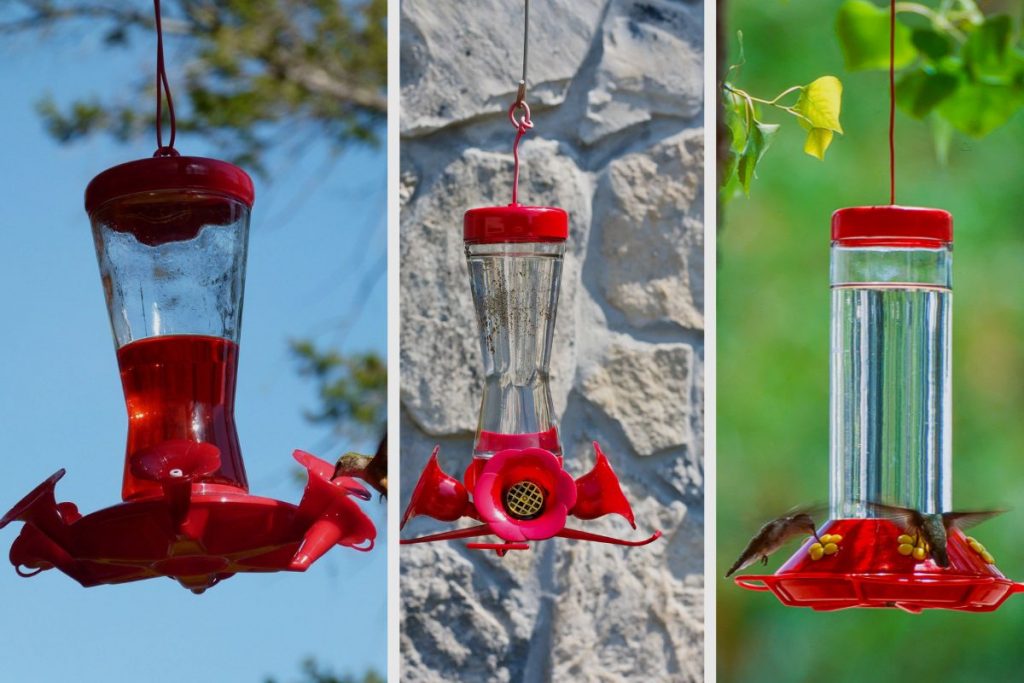
Hummingbird Feeders
Hummingbird feeders come in all sorts of shapes and sizes, whether they are round, flat, or even in a tube. There are different kinds of hummingbird feeders, but the one thing they all have in common is that they all have a way of dispensing nectar. That is because hummingbirds don’t eat seeds or nuts like other birds; they only drink water or nectar, which allows designers to come up with very beautiful and intriguing feeder designs.
Some can be very small, with intricate designs and a single mouth for feeding, and some can be very large, with incredibly large feeding tubes. When it comes to hummingbird feeders, there are so many options to choose from, and there are no wrong answers. All you have to do is pick one that best suits your style and preferences.
There’s also a large contingent of DIY hummingbird feeders that a lot of people make by themselves, and a lot of them come in very unique and creative designs, as well as using materials that they can source from around the house.
Anything can be used to make a hummingbird feeder, whether it’s an old water bottle or even a pipe you found lying around the house. So long as it can hold water and you can create a way to dispense the nectar for your flying friends.
Types of Hummingbird Feeders
Hummingbird feeders can be made of a variety of materials, including glass, plastic, and tubes. However, irrespective of whatever materials you use to create or buy your ready-made feeders, they usually come in two main designs: they can either be inverted feeders or saucer feeders.
Inverted Hummingbird Feeder
Inverted hummingbird feeders are usually suspended with a central reservoir that releases nectar from above to several feeding ports that are used for feeding individual birds as opposed to having them crowd around a central point. Inverted feeders could also have a single feeding point, and as such, they provide space for one bird at a time. A good DIY example is a suspended bottle with a slim tube attached that dispenses water at a drip rate.
Pros
- They make it easier to monitor the nectar levels.
- They usually have a higher capacity
Cons
- They are more prone to leakage and insect attraction
- Cleaning and filling them may be more difficult.
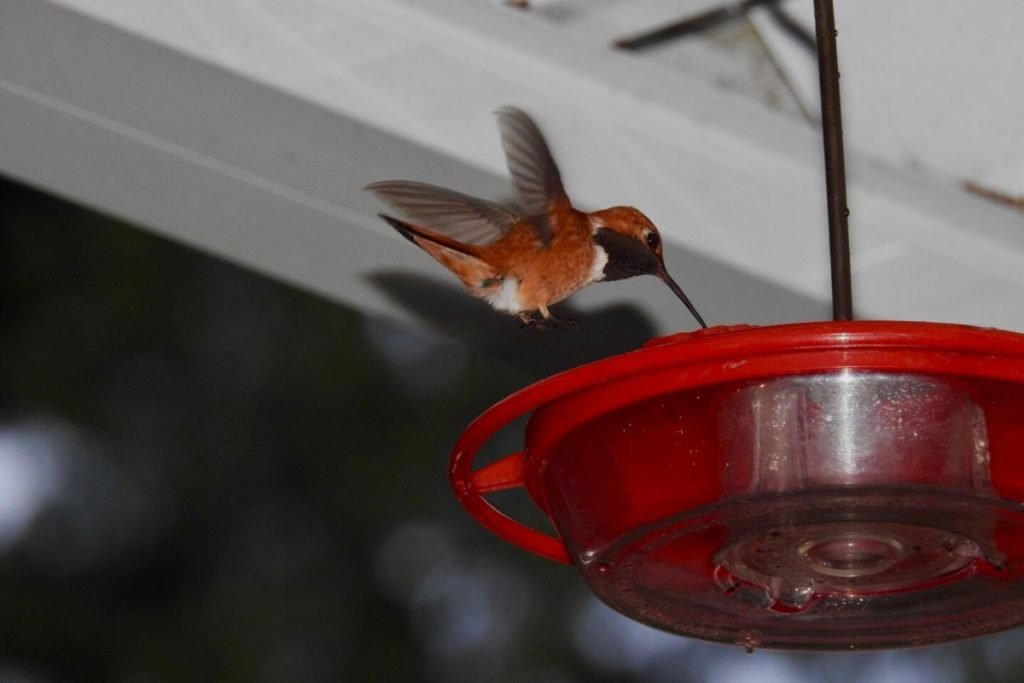
Saucer Hummingbird Feeders
A saucer feeder is a simple, shallow nectar dish with ports above the reservoir that allow birds to dip their bills and tongues directly into the nectar supply. This model allows you to feed multiple birds at once, as they can all circle around the feeder and perch around it.
It is a nice way to have a lot of hummingbirds hang around your feeders at once, and it is a great way to deter one hummingbird from asserting total dominance over one feeder because hummingbirds can be very territorial birds and will actively drive away other hummingbirds from a feeder they like.
Pros
- Filling, cleaning, and assembling are all simple tasks.
- They mount more easily on poles or railings.
Cons
- Because of their smaller capacity, they must be refilled more frequently.
- They might be less visible to passing birds.
A History of Hummingbird Feeders
Laurence J. Webster of Boston created hummingbird feeders for his wife, May Webster, after she read a 1928 National Geographic article about feeding hummers from small glass bottles. Webster had his design made by an MIT lab glassblower between 1929 and 1935. (possibly James Ryan).
Ornithologists refer to May Webster as “The Hummingbird Lady.” She was chosen as an Associate of the A. O. U. in 1936, and she had a strong passion for nature that manifested itself in numerous ways, including through gardening and inviting birds to her house.
She started experimenting with taming wild hummingbirds ten years ago, and her efforts were so successful that friends and others travelled great distances to view the large number of these birds that frequented her gardens and drank from the tubes of treats she prepared for them. In 1932, she established the New Hampshire Nature Camp at Lost River after securing the state reservation for that purpose.
Every summer, she came here and personally oversaw the operation of the camp, which offered a course under qualified instructors to train teachers, camp counsellors, and others for outdoor employment.
In 1947, Harold Edgerton wrote an article for National Geographic about his newly invented strobe flash, which included photos of hummingbirds at Webster’s feeder. The Webster feeder sparked interest, and the Audubon Novelty Company of Medina, NY, offered it for sale in 1950. People have come up with clever designs and incredible features for their feeders since then, and now the world of hummingbird feeders is ever-expanding and always growing.
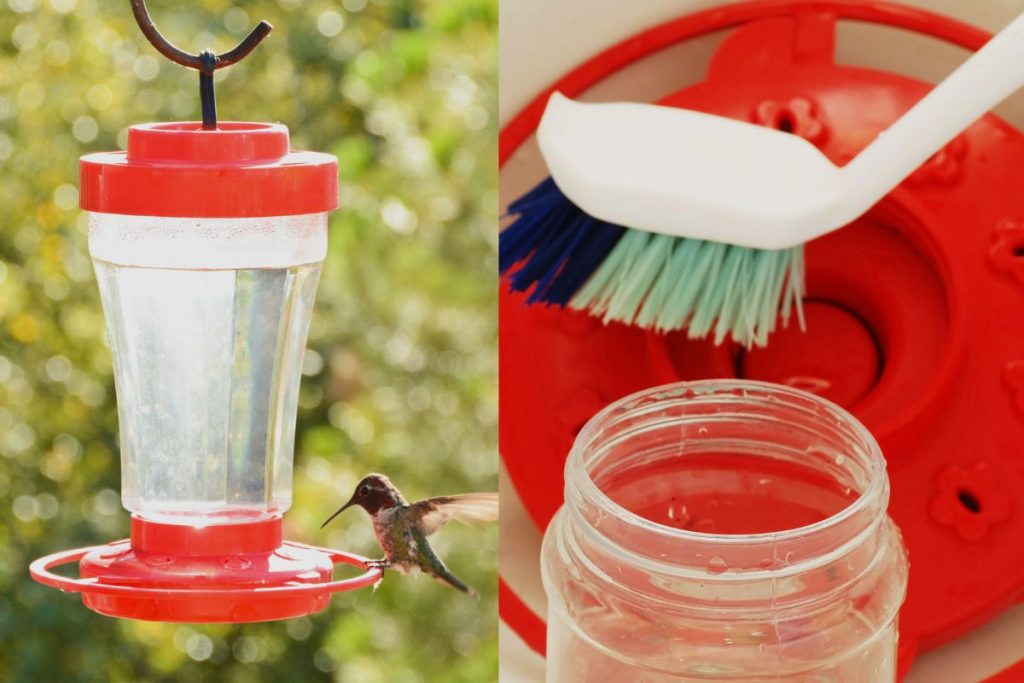
Hummingbird feeder Maintenance
Maintaining your hummingbird feeders is a very important task that requires your utmost attention, as, without proper maintenance and cleaning, your feeders can become contaminated with bird faeces and can become very dirty. As we all know, hummingbirds will not come to dirty feeders. So, regularly cleaning and changing the water or nectar in your feeders is a very important task that shouldn’t be taken lightly. However, cleaning and refilling your hummingbird feeder is a very simple task that anyone can do.
Cleaning
You should clean out your feeders at least once a day or every two days, but no more than that because dirt will accumulate even if your feeder does not appear dirty right away. You can clean your bird feeders with any type of mild solution of soap and hot water, and you can use a toothbrush or a Q-tip to get to those hard-to-reach spots and thoroughly clean your hummingbird feeders.
Cleaning your hummingbird feeders is critical because it improves the health of the birds who drink from them and keeps them coming back, unlike traditional bird feeders, which contain seeds that will spoil. The main issue with not cleaning your hummingbird feeder is that the water or nectar becomes contaminated.
Refilling
Your hummingbird feeders should be constantly refilled after being used. The heat will warm up the water or nectar in your feeder, and hummingbirds don’t like to drink hot water or nectar, so you may need to change it out at least twice or three times per day if it’s a particularly hot day.
Additionally, keep in mind to clean out your hummingbird feeders at night after all the birds have left. Never let the water or nectar sit for more than a day before thinking about changing it. Additionally, as a general rule, you should always clean the feeder after each day.
Hummingbird Feeder Locations
Hummingbird feeders should be placed somewhere quiet and shaded, perhaps under your roof, so that birds of prey do not see them. It should also be in a location where you can easily see and reach it so that you can change the water in it regularly. They should also be elevated above the ground to avoid predators such as cats and rodents. You can also place them in your gardens and backyards, which are full of flowers and plants that will draw them in.
Your bird feeder should be placed in a place where hummingbirds feel secure and at home
. When hummingbirds are close to natural covers, such as trees, shrubs, or other vegetation, they are probably more comfortable feeding.
Near Flowering Plants
Another great location for placing your hummingbird feeders is near flowering plants that are in full bloom. If you enjoy having hummingbirds come around your home, then a surefire way to attract them is to place your feeders near flowering plants. If you want to try planting particular flowers to entice more hummingbirds to your yard, be sure to pick local species.
To ensure that your garden has blooming flowers throughout the spring and summer, think about developing a flowering calendar. Also, some hummingbird feeders look like flowers, and they can easily make your home look very lovely, especially if you can get your hummingbird feeders decorated properly.
Best Heights
As I had previously stated, you should place all of your feeders very high above the ground to avoid pests and predators attacking your feeders and birds. So, as a rule of thumb, you should be thinking about placing your hummingbird feeders anywhere above 6ft in the air. You can also place them on your window sills and underneath your roofs.
However, you should always make sure to place them in a location that you can reach because you have to be able to clean them and refill the water inside of them. So, always make sure to ask yourself, “If you can always reach this feeder comfortably and clean it regularly,” because cleaning and reaching them is as important as keeping your feeders safe from predators and rodents.
Best Distances
Feeders should be hung or mounted more than 3 feet away from windows or more than 15 feet away from windows to help prevent fatal window collisions. Hummingbirds may frequent your feeder more frequently if it is placed close to flowerbeds or other planters.
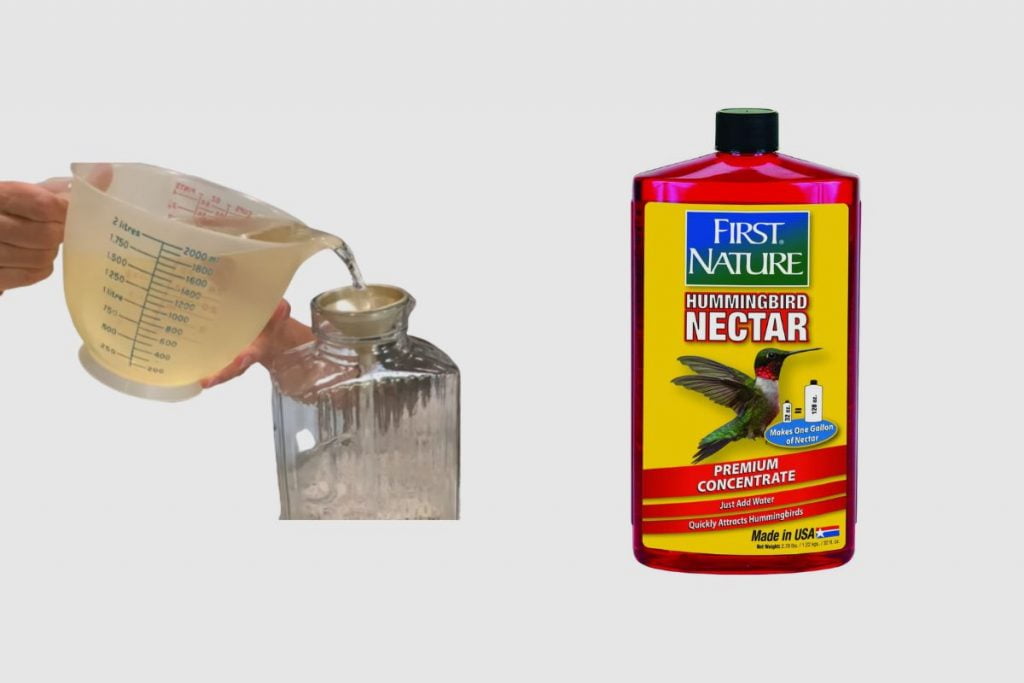
Different Types of Nectar
There are different kinds of nectar you can use to feed your hummingbirds. Whether you buy store-bought nectars like First Nature 3054 Red Hummingbird Nectar or make your own homebrew recipes, you and your hummingbird friends will always have a variety of options to choose from.
I personally love making a homemade recipe of sugar and water because it is so simple and easy to make and requires no hassle at all. Although, that is because I’m a DIY hummingbird watcher, and I love “Do It Yourself” recipes and designs. However, that doesn’t mean buying store-bought hummingbird nectar is bad. There are a lot of quality hummingbird nectars available on the market, and in the end, it all depends on your personal preference.
Homemade Nectar
Homemade nectar recipes are a great way to not only enjoy the process of birdwatching but also to introduce children to the world of birdwatching. You can get your kids to make some simple recipes that they can then dispense into the feeders. I’ve always found that allowing your children to participate in some of your hobbies brings you closer together, and you can start to enjoy a lot of the same things together.
Also, when children make the nectar and get to watch the hummingbirds drink it, they get attached to the birds, which makes the process all the more satisfying because they feel the birds are drinking something they made.
This simple sugar nectar recipe is still by far the best and most reliable recipe out there;
- Mix 1-part sugar with 4 parts lightly boiled water (for example, 1 cup of sugar with 4 cups of water) until the sugar is dissolved
- The red dye should not be used.
- Place your hummingbird feeders outside and fill them with sugar water.
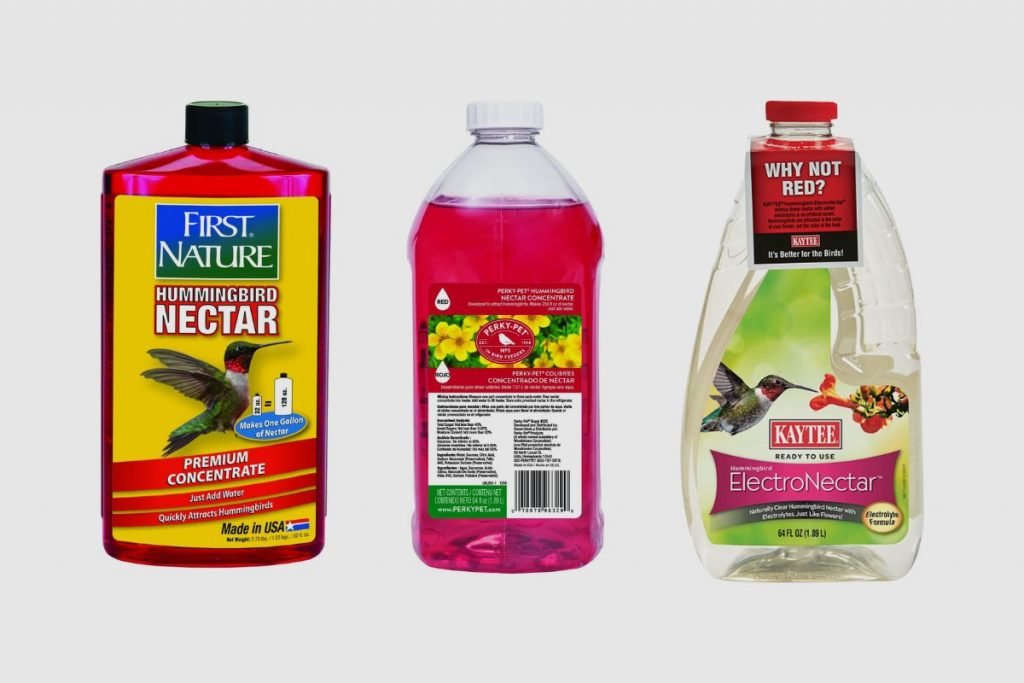
Store-bought Nectar
When raising a hummingbird community, there are numerous factors to take into account. You may require several excellent hummingbird feeders, the proper cleaning supplies and methods, and, of course, some excellent nectar. Here are a few of my favourite nectar blends that will keep your little hummers happy, healthy, and eager to eat more. Buying your nectar from a store or pet shop is a good way to add variety to your hummingbird feeders.
1. First Nature 3054 Red Hummingbird Nectar, 32-Ounce Concentrate
This nectar’s crimson colour will attract hummingbirds, but it also contains only the best ingredients. To keep your tiny hummers healthy and happy, the best sucrose is used in the specific solution. I found this nectar on Amazon for about $12.
2. Perky-Pet 255 Hummingbird Nectar 64 Oz Liquid Concentrate
Made entirely with sucrose, the sucrose nectars closely resemble genuine flower nectar and give hummingbirds the vital energy they require to survive. The red nectar is enticing because it resembles the vividly coloured flowers that hummingbirds visit in nature. I found the 64-ounce and 16-ounce versions for $15 and $12, respectively, on Amazon.
3. Kaytee Hummingbird ElectroNectar Wild Bird Food, Ready to Use, 64 Ounces
Hummingbirds are drawn to the formula’s naturally pure nectar, which also moisturises and nourishes them. Because it is already prepared, omit the sugar and water. I found this on Amazon for $12.
Hummingbird Feeder Benefits
- The main advantage of using a hummingbird feeder is that it attracts hummingbirds and allows you to observe them closely.
- They allow you to observe hummingbirds and other birds interacting.
- Hummingbird feeders also add beauty to your home because some of them are very attractive and will only serve to decorate your home while also attracting hummingbirds.
- Hummingbirds are very beautiful birds that aid in the pollination of plants and flowers. So, if you have a lot of hummingbirds in your yard, you can enjoy the added benefit of more flowers growing around your house.
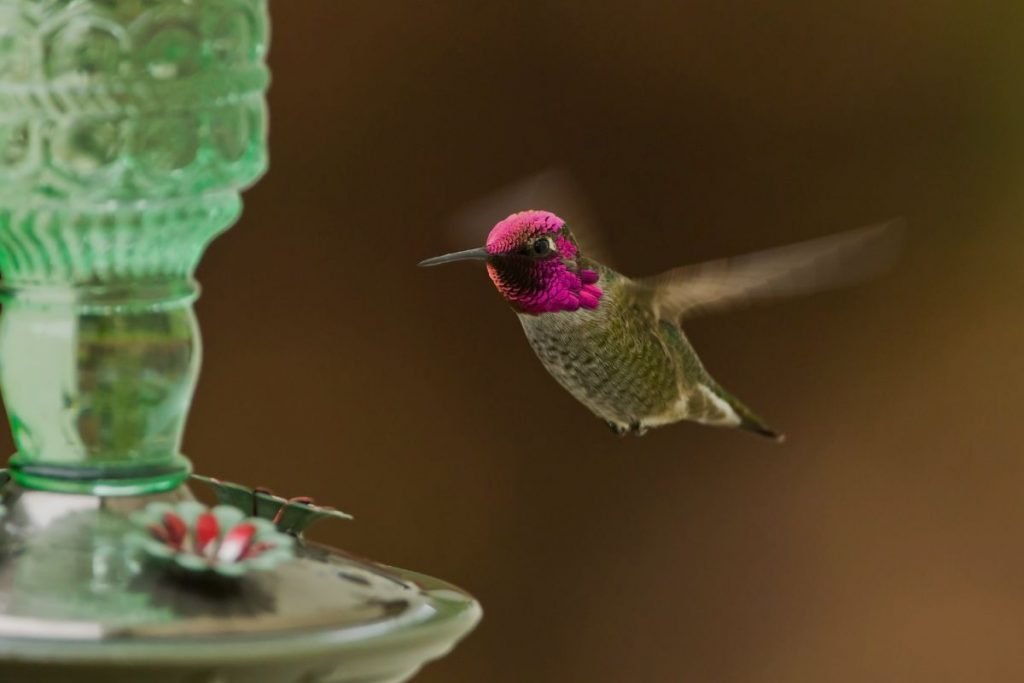
Hummingbird Feeder Hazards
There are a few hazards that could affect your hummingbird feeders, like fermenting nectar and microbes affecting the drinking water, as well as predators harming your favourite birds. So, it is very important to know what to look out for as potential hazards that may affect your hummingbird feeders, as well as some quick solutions that could make it easier for you to monitor your favourite flying visitors.
Fermenting Nectar
Fermenting or still-nectar is one of the most common threats to hummingbird feeders. It is a very common occurrence to find hummingbird feeders with distilled or fermented nectar that has sat in the feeder for a few days. Feeding nectars do not last very long and are supposed to be changed regularly, at least once or twice a day. It is very easy for nectar to go bad if it isn’t monitored or changed regularly. Once the nectar goes bad, the hummingbirds will know, and they will slowly stop coming by, especially if you continue to neglect your feeders. So, make sure you change the nectar in your feeders regularly.
Unsafe Feeders
A feeder could be classified as unsafe for a variety of reasons; it could have fermented or unclean nectar. It could be placed in locations that are susceptible to insects and predators, and it could also have a wide variety of other things, like a broken hinge or a dirty dispenser.
The most important thing for you to do when you are trying to maintain your hummingbird feeder is to always try to pay attention to your birds and feeders. If they happen to stop coming by as frequently as they used to, maybe there’s an issue with the feeder, or maybe they don’t feel the placement of the feeder is safe (maybe your pet cat has started to hang around them a little too much).
So, maybe you could think about changing your hummingbird feeder’s location; it could be a little higher up or a little closer to your garden. Just remember to always pay close attention to your feeders and little patrons.

Hummingbird Feeder Accessories
There are a wide variety of hummingbird feeder accessories that you could attach to your feeders to make them more accommodating, safer, and even prettier. It’s all about what you think they need and what you think would fit. You can pick out things like an ant moat, more perches, a mini feeder attachment, or even a small makeshift nest for them to crash in.
You should have fun when you are picking out a set of accessories to personalise and improve your hummingbird feeders. Feel free to put anything you can fit onto it; I’m sure the birds won’t mind. So, have fun when you’re accessorising your hummingbird feeders.
Ant Moats
An ant moat is a trap that is filled with water and prevents the ants from crossing over to the hummingbird nectar ports when they climb onto the feeder. And it’s a great way to keep those pesky ants from falling into the nectar or going around the feeders and scaring the birds away. An ant moat could also be known as an ant guard, so you should keep that in mind when you’re trying to buy one, and you don’t happen to see the same name for it.
You can buy a hummingbird feeder with an ant moat built in, add a guard or moat to an existing feeder, or make your own. If you do not already have a hummingbird feeder with an ant moat built in, such as the Ultra Hummzinger, you can add one by attaching it between the feeder and the hanger rod, as shown in the ant trap below. Simply fill the moat with water, and ants will enter, but they will be unable to exit—and, more importantly, they will be unable to access your hummingbird feeder.
If you have a lot of ants, make sure to keep the moat clean and empty the dead ants out frequently, or else a “bridge” will form that the ants can use to cross over the water to your feeder.
I recommend the following moats:
1. Skinny Copper Ant Moat
Instead of using water to repel ants, simply coat the inside of the Skinny Copper Ant Moat with a few drops of vegetable oil, which appears to be very effective.
2. Ant Guard with Ant Repellent
Instead of a water moat, you can attach an ant guard with an ant repellent to keep them away from your feeder. Perky-Pet Ant Guard contains permethrin, an insecticide commonly used to treat scabies and control mosquitoes, and is found in pet products and insect repellent sprays. It is also safe to use around birds.
Extra Perches
You could also think about adding a few more perches to your hummingbird feeders to allow you to have a few more birds come around, and as we all know, the more, the merrier. So, it’s always a good idea to have a few more birds around your home. So, why not add a few perches to your feeders? The best ones I have seen are DIY designs because they always give you a chance to express yourself in the best and most creative ways possible.
Some Popular Brands
There are a few hummingbird feeder companies that have dominated the market due to a consistent track record of selling high-quality hummingbird feeders, such as Perky-Pet, BOLITE, and Droll Yankees.
Perky-Pet
Perky-Pets manufactures a complete line of wild bird feeders and accessories, including seed feeders, birdhouses, hummingbird feeders, waterers, nectars, and oriole feeders, allowing bird feeders to enjoy their bird feeding experience.

High-Quality Perky-Pet hummingbird feeders;
1. The Perky-Pet 209B-1SR is one of the Best Glass Hummingbird Feeders with Perches, Built-in Ant Moat and Bee Guards ($21).
2. The Perky-Pet 203CPBN-2 Pinch-Waist Glass Hummingbird Feeder with Perches, Built-in Ant Moat and Bee Guards ($20).
3. The Perky-Pet 220 The Grand Master 48-Ounce Hummingbird Feeder ($18).
BOLITE
For many years, BOLITE has focused on bird feeders, hummingbird feeders, and other similar products. They are committed to providing high-quality products and services to all birdwatchers and enthusiasts.
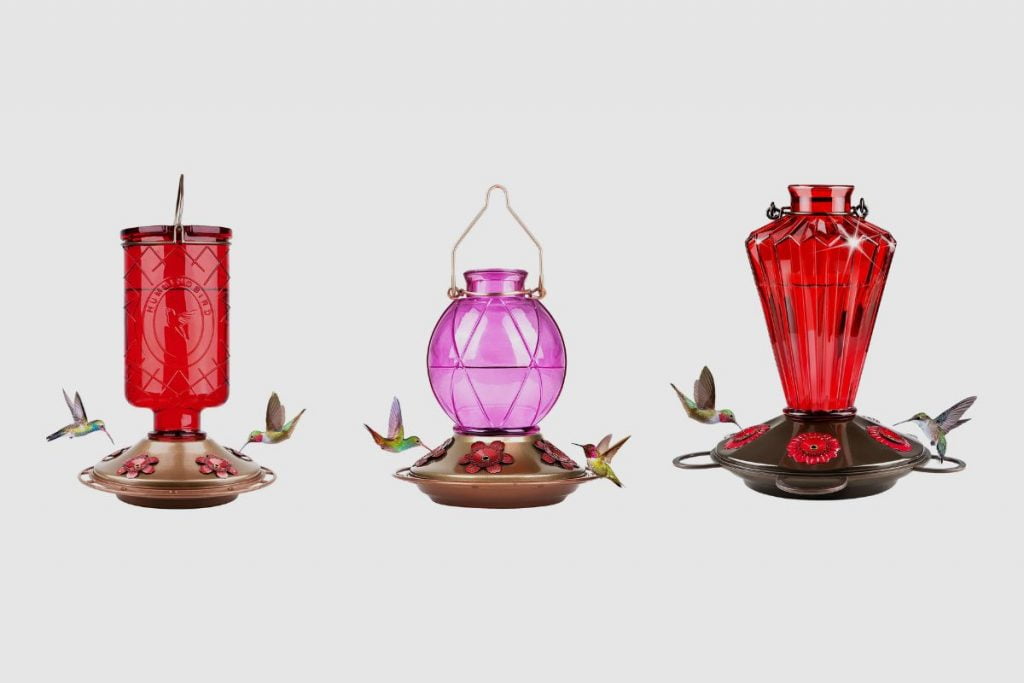
High-Quality BOLITE Hummingbird Feeders
1. BOLITE Hummingbird Feeder, 18005 Glass Hummingbird Feeders for Outdoors, 5 Feeding Stations, 22 Ounces, Red Bottle ($18)
2. BOLITE 18016-P Hummingbird Feeder, Glass Hummingbird Feeder for Outdoors, Netted Texture Ball Shape Bottle, 18 Ounces, Lavender ($16)
3. Droll Yankees BOLITE 18017-R Hummingbird Feeder, Glass Hummingbird Feeder for Outdoors, Diamond Shape Bottle for Outdoors, 20 Ounces, Red ($22)
Droll Yankees manufactures and sells wild bird feeders through an online platform, allowing bird lovers to select from a variety of styles that are simple to fill and clean and come with a lifetime warranty.

High-Quality Droll Yankees Hummingbird Feeders
1. Droll Yankees Hummingbird, Outdoor Feeder with Hanger and Ant G, 7.125″ Dia, Beige ($31)
2. Droll Yankees C-6HB Classic Hb Bird Feeder Red 344581 16oz ($28)
3. Droll Yankees Hummingbird Feeder with Hanger, Ruby Slipper Red Feeder, 5 Ounce Nectar Capacity, Ruby/Clear, RS-3HC ($18)
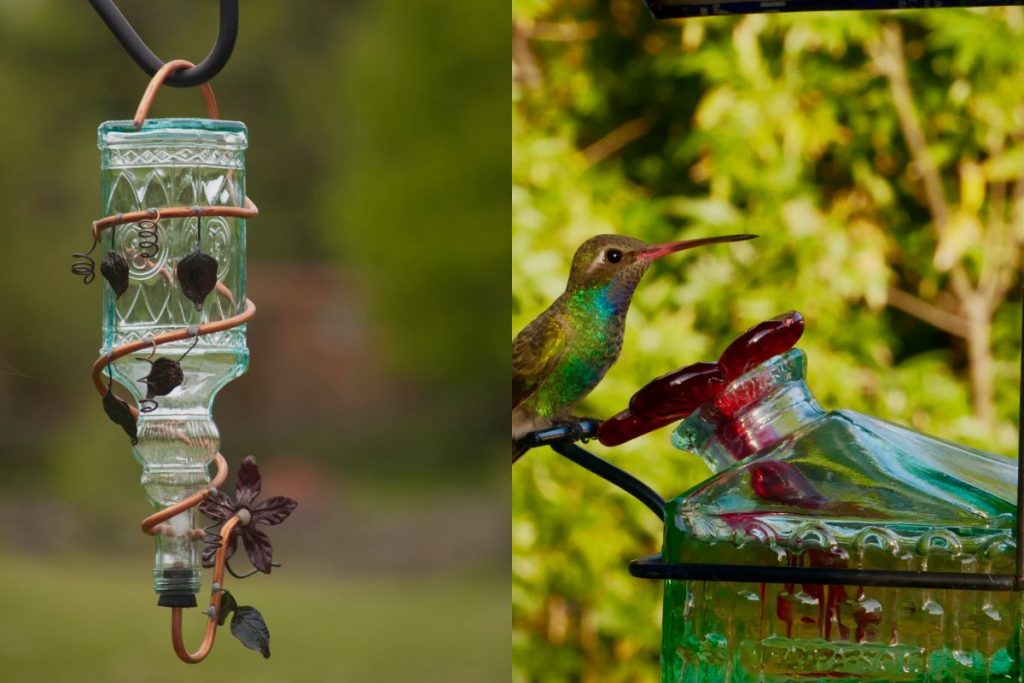
DIY Hummingbird Feeders
A DIY hummingbird feeder, as the name implies, is a “Do It Yourself” hummingbird feeder. It is a feeder that you make by yourself or with your friends and family. It is usually made from materials that you find around your home or with random items that weren’t actually designed to be hummingbird feeders. So, as long as you don’t buy it from a store and it’s not mass-produced, it’s fine to call it a DIY hummingbird feeder.
Personally, I find it the best way to get into hummingbirds and bird watching in general. It gives you a chance to come up with creative, one-of-a-kind designs that only you could come up with. It is also a great way to engage in creative recycling, which is good for the environment.
The DIY culture around hummingbird feeders is becoming more mainstream as more and more people seek to create all kinds of wacky and creative designs. It’s a great way to express yourself and also help the environment. It is also one of the many ways I get to bond with my kids. We all enjoy making our own special designs, painting them, making ant moats, attaching the hooks, and putting them all together. I think it’s a great way to bond with your family and enjoy some downtime.
Materials
As far as materials go, you can make your hummingbird feeders out of anything: bottles, cups, mugs, wood, glass, plastics, tubes, rubber, and even old lanterns. The essence of DIY hummingbird feeders is expression and creativity. So long as your feeders can dispense water or nectar in a clean and sanitary manner, then, by all means, create as many feeders as your heart desires. I have a friend who makes hummingbird feeders out of recycled tyre material, and some of her designs are absolutely amazing.
Assembly
As I have already explained, there is no set way to make your own hummingbird feeder, so there isn’t an exact assembly process. So, as long as your materials are clean, you have a central water reservoir, and a place for the birds to perch, you should be fine. Be as creative as you want because, in the end, you’re just doing it for yourself, so design something you like.
Maintenance
Maintenance is very important, whether you are making your own feeders or buying them. You have to take proper care of them, and that involves cleaning them regularly and always changing out the water in them every day. You have to look after your hummingbird feeders or risk making them unsafe for your friendly flying neighbours. To reach those hard-to-reach areas, use a small polyester brush or pipe cleaner and clean the insides of the tubes from which you dispense water.
Hummingbird feeder designs
Hummingbird feeders come in all kinds of different shapes and sizes; there are some small ones and some big ones. Whether you are buying them from your local department store or pet shop, there’s a wide variety of designs, colours, and materials they can come in, and if you are into DIY, then there’s a whole world of designs and models you can buy.
There are big and bulky ones, small and slim ones, and there are even ones made of tubes and funnels. There are so many designs that it’s hard to keep track of them all. I’ve made no secret of my general fondness for DIY designs and how I think they are the best way to do it.
However, some big brands like Perky-Pet and BOLITE have some incredible and simply breathtaking designs. Take the BOLITE 18018-R Hummingbird Feeder, Glass Hummingbird Feeder, which is designed like a diamond lantern which I find very beautiful, and it just fits with a backyard aesthetic.
One of the easiest DIY designs I know of is to use an old plastic Tupperware container and poke a few holes in it for the hummingbirds to feed from there. Then maybe you could just place it outside your window and watch as the hummingbirds come and drink from it.
Materials
As for materials, there are a wide variety of material options you can choose from. There are glass designs, plastic designs, and even some tube designs. There are so many options and designs to pick from that, as a hummingbird watcher, you are always spoiled for choice with the options you can pick from.
Hummingbird Feeder Regulations
As far as government regulations go, there really aren’t any limitations or quotas imposed by the government on how many hummingbird feeders you can have in your home. However, there may be some local zoning laws around your city that you may have to follow, but I’m very sure they don’t still have any limitations on your hummingbird feeders. It wouldn’t hurt to look into some of your local council area laws, though.
You may also have some neighbourhood rules that you could look into, but I doubt you’ll find anything about a bird feeder in there. However, there may be limitations on decorations around your home outside of seasonal occasions, so you may want to check what your neighbourhood association has to say.

Hummingbird Feeder Problems and Predators
Hummingbirds are vulnerable to predators and other hazards, just like all other birds. Home birdwatchers should take precautions to safeguard these fluttering gems by being aware of what animals might be on the hunt for a hummingbird snack and what significant backyard threats hummingbirds face.
A Closer Look at Some Hummingbird Predators
For a human, an adult hummingbird may not seem like a significant source of food, but for an animal predator, it can be a nice, quick snack. During the late summer and early fall, when hummingbirds prepare for migration, plump hummingbirds are full of sweet nectar and healthy sources of fat. Numerous predators won’t hesitate to chase hummingbirds, including;
- Hummingbirds may be mistaken for toys by domestic and feral cats due to their vibrant colours and dazzling feathers.
- Large insects like orb-weaver spiders and praying mantises may wait for hummingbirds to get too close before attacking.
- Large snakes and lizards that have the potential to attack hummingbirds may also frequent feeders for nectar.
- Fish and large frogs that may confuse low-flying hummingbirds for insects and leap out of the water to catch the birds may also do this.
- Birds that consume other birds, including little hummers, include aviators like the loggerhead shrike and greater roadrunner.
- The American kestrel, Merlin, and sharp-shinned hawk are examples of small raptors that hunt both large insects and smaller birds like hummingbirds.
- When hummingbirds are in torpor, they are less able to defend themselves, making them an easy meal for owls to catch.
These predators frequently stake out feeding locations, like flowerbeds or hummingbird feeders, and wait for a hummingbird to fly close enough to them before attacking. When hummingbirds consume, they are more concerned with the food source than with potential dangers around them, and those brief minutes of sipping can put them in danger from cunning predators.
Deterring Predators
There are several actions you can take to help defend your local hummingbirds from potential predators. So, here are a few ideas you can work with
Place baffles above and below hummingbird feeders, and place feeders distant from any potential hiding places for predators.
Keep pet cats indoors at all times and take aggressive measures to deter wild cats so they can’t stalk hummingbirds.
Watch hummingbird nests carefully for intruding predators, but exercise caution to avoid alarming the female parent hummingbird or drawing unwanted attention to the nest.
Any predatory insects, lizards, or snakes should be kept away from hummingbird feeders, nests, and preferred flowerbeds.
Give resting hummingbirds protected perches, so they aren’t more vulnerable to predators or exposed to predation.
Make sure your landscaping is bird-friendly by having prickly shrubs that may be utilized as safe nesting locations and that naturally keep out the majority of predators. This will give small birds enough refuge.
Hummingbird feeders should be hung high enough to deter predators and far enough away from railings to prevent them from gaining access to feeding birds.
Despite their best efforts, hummingbirds are occasionally preyed upon by predators. It is critical to recognize that this is a natural cycle, and the strongest hummingbirds will survive to pass on their superior genes and survival skills to the next generation.
Other Threats to Hummingbirds and Ways to Deal with them
Artificial dangers to hummingbird populations can be just as harmful as natural ones, even though hummingbird predators pose a serious hazard to these small birds. As a home birdwatcher, you should take precautions to ensure that their yards do not pose an additional threat to hummingbirds, in addition to being mindful of potential predators that might hurt the birds.
Reduce bird-window collisions by spacing feeders properly and breaking up reflective surfaces that can confuse birds. Even a minor collision can be fatal to a hummingbird, and if its bill is damaged in a collision, it may be unable to feed.
Local bird rescue centres and rehabilitators who are licenced to care for sick or injured hummingbirds should be avoided. This way, any birds that do come into contact with predators can receive proper emergency care when even a few minutes can mean the difference between life and death.
We must look after our backyard neighbours by taking active steps to learn about their threats and predators. It is also important that we look after them by simply paying attention to them because there is a lot we can notice by simply paying attention.

Hummingbird Feeder Trivia
Hummingbirds are very interesting birds, and their feeders are also very interesting. So, here are a few facts about hummingbirds and their feeders that you probably didn’t know.
Avoidable Feeding Risks
Other mixes beyond sugar water have occasionally been suggested for hummingbird feeding. They all pose unacceptably high hazards. This is particularly accurate for honey-water concoctions. In addition to being an unnatural food source for hummingbirds, honey spoils considerably faster than sugar water and has some bacteria that can lead to a fungal disease on the tongue. The condition is invariably lethal.
Contrarily, white sugar contains the same type of sucrose as flower nectar. The strength of floral nectar can be closely compared to the strength of 1 part sugar in 4 parts water. Stronger concentrations negatively impact the livers of captive birds, but smaller quantities are less alluring to hummingbirds.
Additionally, mixes that include nutritional supplements are dangerous and should be avoided. Protein supplements are not only useless but also potentially dangerous for hummingbirds because they supplement their nectar diet with things they discover in the outdoors.
Red food colouring has the same properties. Red food colouring is frequently added to concoctions as an artificial colour so that hummingbirds, which are well known for their love of the colour red, will be drawn to the feeder right away.
Red food colouring’s safety has been questioned concerning its use in ingestible foods. The majority of commercial feeders are already coloured red or ornamented with red plastic flowers. Therefore, it is unnecessary and may be dangerous to add red food colouring. Once hummingbirds discover a feeder, they continue to come to it regardless of its colour.
Cleaning Your Feeders
Additionally, it is necessary to clean feeders every three days in hot weather and every six to seven days in cool weather. If you leave the solution in the feeder for too long, the solution may start to look hazy and begin to grow dangerous mould or germs. Hazardous germs and moulds put hummingbirds at risk for illness and, perhaps, death.
Here are 5 fun facts about hummingbirds.
- They are the tiniest migrating bird.
- Hummingbirds get their name from the humming sound their wings make as they beat so quickly.
- The only birds that can fly backwards are hummingbirds.
- Hummingbirds lack a sense of smell.
- A hummingbird weighs less than a nickel on average.

Hummingbird Feeder Buying Tips
When you plan on buying a hummingbird feeder, you have to look out for a few key things. So, here are a few tips to keep in mind when buying a hummingbird feeder.
When you are buying a hummingbird feeder, you have to make sure that your feeders are within your budget. You have to have a specific target in mind when you plan on buying a hummingbird feeder. Another thing to note when buying a hummingbird feeder is the size. When you start out as a home birdwatcher, you have to start with a small feeder.
Don’t spring for the bigger, more expensive one when you know that you won’t be getting a lot of hummingbirds. It is also important to note that you should only expand your feeders when you start getting more birds. It is also important to know the level of hummingbird activity in your area. If your city gets a lot of hummingbird traffic, then you are more likely to get more birds around your feeders. The key to buying a feeder is to start small and then grow from there.
Accessibility and ease of use
The main thing about hummingbird feeder accessibility, in my opinion, should be a focus on the number of perches that the birds can get from them. It should give you a chance to have as many birds as possible on a single feeder. When it appears that there is no more room for them to feed, consider getting another feeder.
As far as ease of use goes, hummingbird feeders are very simple and easy to use. All you have to do is fill them up with your nectar of choice, whether homemade or store-bought, then hang your feeders up and watch the hummingbirds come by for a sip.
Conclusion
Getting started as a hummingbird watcher and feeder can seem like a complicated task, but when you go through this comprehensive guide I have designed, you will surely get to know everything there is to know about hummingbird feeders, including how to protect them, how to keep them clean, how to build them yourself, where to get them from, some of the best ones you can buy, the best nectar brands, and everything in between.
I hope you found this article useful and that it helps you get into the wondrous world of home birdwatching. Thanks for reading.
Image Gallery – Hummingbird Feeders Comprehensive Guide














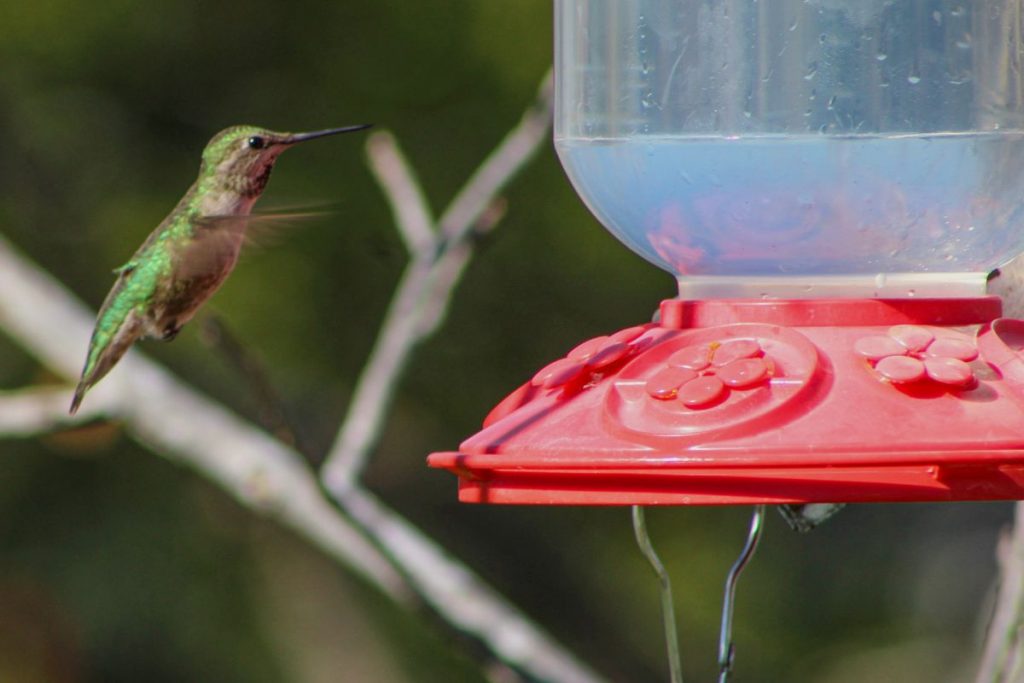
References: Hummingbird, Bird Feeder, Laurence J. Webster, May Webster.
